When we took apart Apple’s thinnest-ever pocket computer, we admired its impressive engineering in a surprisingly repairable 5.6mm-thin package. We were even more surprised to discover that the MagSafe charger uses the same battery found inside the phone itself (and they’re even interchangeable!). The initial excitement may have quieted, perhaps too much if reports of production cuts are to be believed.
But our microscope analysis of the iPhone Air’s 3D printed USB-C port set off a small firestorm in the metal 3D printing world. We’ve been talking to a bunch of additive manufacturing experts over the last six weeks, and with Apple confirming some of our key findings, it’s time to share back with the class.
So, how did they do it? How is the first 3D-printed iPhone part made?

Big Noise about a Little Port
We cheered with the world when the EU standardized charging ports for electronics. But when we tear down a phone and get down to the ports, we’re most interested in whether they’re modular: If they get damaged, can you swap them out?
In this case, ehh, sort of. It’s a hassle, more complicated than ideal.
This time, though, Apple told the world that we should look a little closer at that port: its housing is 3D printed using recycled titanium, via laser powder bed fusion printers from BLT. This additive manufacturing process debuted simultaneously with the 3D-printed titanium shells in the Apple Watch Series 11 and Ultra 3.
It’s cool to finally see 3D printing become capable of this sort of high-scale production. The shift to 3D printing also provides a significant benefit for sustainability nerds like ourselves: Apple reports that this process saves 33% to 50% in material consumption over traditional forging methods. At a time when overconsumption is a major concern, efficient resource use is a welcome development.
The Mystery of the Crop Circle Pattern
Once we’d taken apart the iPhone Air, we had to put the USB-C port under our Evident DSX2000 microscope. Magnified images of the USB-C port revealed a perplexing detail: a chainlink-like, circular surface pattern that stumped 3D printing veterans. At the 50µm scale, this pattern seemed highly unusual.
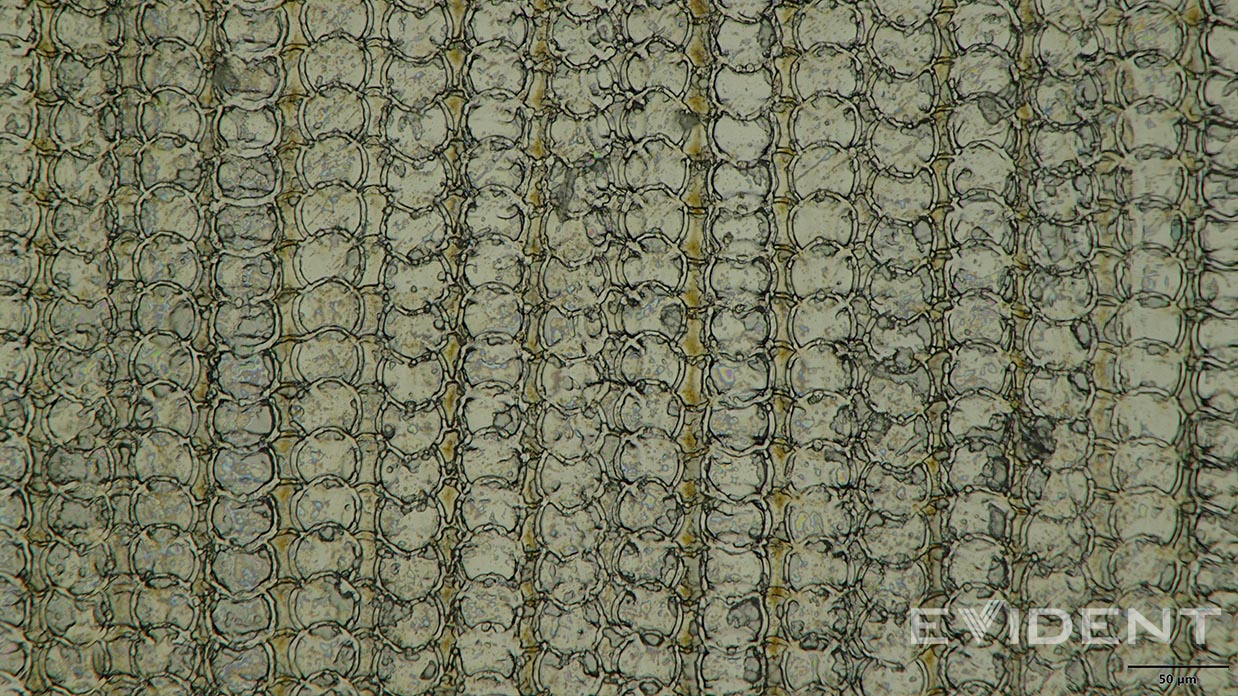
Early reports had suggested that Apple might be using binder jetting, a 3D printing process that involves joining a powder with a binder material, which acts as an adhesive. Two years ago, when it was first reported that Apple was experimenting with using 3D printing for Apple Watch cases, a Chinese company called EasyMFG showed off smartwatch cases printed via binder jetting.
But under a microscope, binder jetting tends to look far less regular than the crop circle pattern we were seeing in the USB-C port housing. So our industry contacts doubted that was the process we were seeing here.
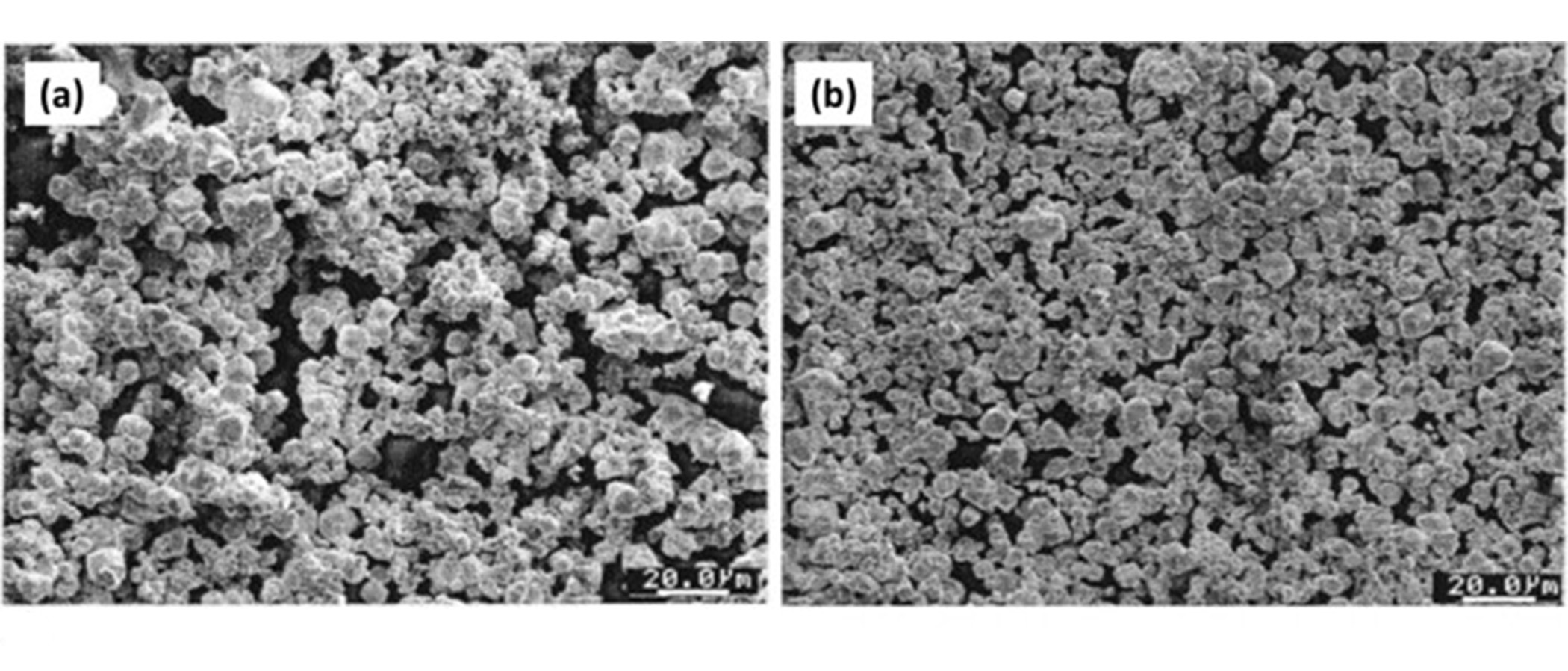
We found a potential clue to its origins in an unlikely place: a six-year-old Nature article from the medical field. It highlights the benefits of creating 10-50µm structures on titanium surfaces using pulsed laser ablation to introduce anti-bacterial properties in prosthetics.
Binder jetting builds parts layer by layer by selectively depositing a liquid binder onto powdered material, which is later sintered or infiltrated to achieve full strength. On the other hand, pulsed laser ablation uses intense, short laser pulses to vaporize material from a solid target, ejecting atoms or clusters that can redeposit as thin films or coatings. In short, binder jetting bonds powder with a liquid adhesive to create 3D structures, while pulsed laser ablation removes or deposits material using concentrated laser energy.
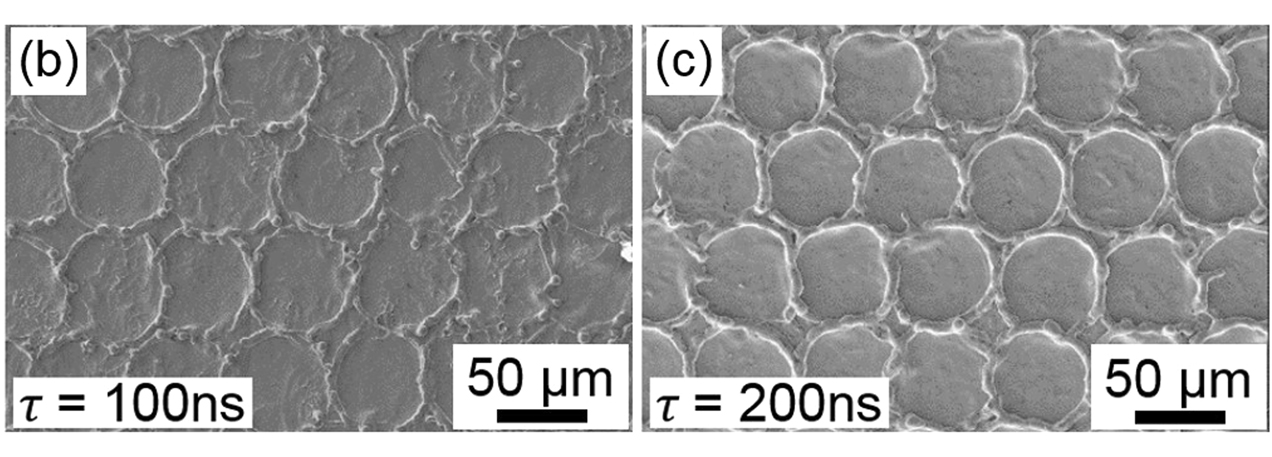
I need to make a crucial clarification here: Despite the fascinating parallel, the USB-C port does not have antibacterial properties. The roughly 30µm circular structures we see are not small enough; they would require additional indentations at the 5-10µm scale to repel bacteria, as shown in related research.

However, the similar pattern and size, while not definitive proof, suggest that a pulsed laser methodology may have been used. Furthermore, images show outlines of a subsurface layer with the same patterns, suggesting the technique was used throughout the printing process, not just on the outer layer.
Sure enough, Apple yesterday published an article describing the process they used: A sea of machines each housing six lasers that build up 900 layers of titanium to create each Apple Watch case. That description, although it doesn’t explicitly term the process “pulsed laser ablation,” confirms that our experts came to the right conclusion.
Why Might Apple Pick Pulsed Laser Ablation?
Apple’s article leans hard on the environmental benefits of 3D-printed titanium, directly connecting the choice to the company’s goal of carbon neutrality by 2030.
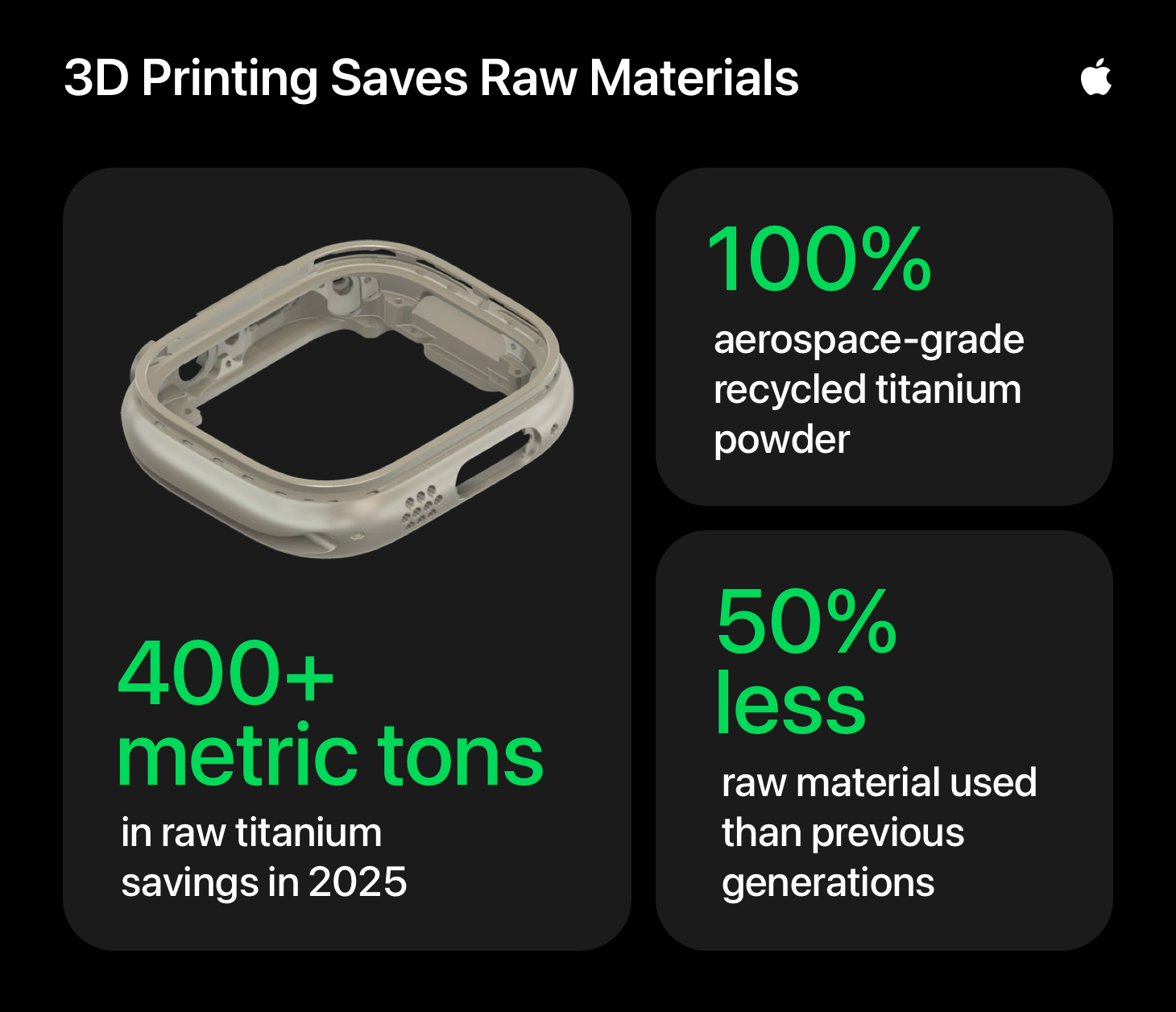
Printing instead of stamping will save them 400+ metric tons of raw titanium this year, a significant chunk of the 7000 tons they’re reportedly using per year. The environmental upside of mining less metal and having less manufacturing waste is clear, and the financial upside is implied: the titanium market has been unstable, and since most titanium processing happens in China, titanium is subject to the ever-changing tariff landscape.
But pulsed laser ablation has some other benefits that could’ve been appealing for the iPhone Air and Apple Watch Series 11 and Ultra 3.
It’s Not as Hot
The short pulses (typically in the nanosecond to femtosecond range) minimize heat diffusion, preventing warping or discoloration when melting the 50µ pellets of titanium powder. Discoloration might not matter much on a tiny part inside the iPhone Air, but it certainly matters for the case of the Apple Watch.
Apple’s article mentions the need to control heat by refining the recycled titanium to a less oxygen rich mixture; it’s probable that using micropulses to vaporise the titanium alloy powder lends them another means of controlling the energy transfer from the laser to the heat sensitive titanium alloy powder.
It Can Make Useful Surface Finishes
Our experts suspected that the crop circle-like micro-texture could possibly serve a purpose in assembly of the iPhone Air. It might improve adhesion for waterproofing seals or coatings around the port.
Indeed, Apple names this benefit as a core feature of the 3D-printed titanium in the Apple Watch. Their process allowed them, they say, to
“improve the waterproofing process for the antenna housing in cellular models. Within the case, cellular models have a split filled with plastic to enable antenna functionality, and 3D-printing a specific texture on the inner surface of the metal enabled Apple to achieve better bonding between plastic and metal.”
It’s not a big stretch to think the USB-C port might be experiencing a similar benefit.
It’s Precise
Pulsed lasers can sculpt or texture metal surfaces with sub-micrometer accuracy, ideal for shaping the tight tolerances around a USB-C port or cleaning up weld areas after machining. Given that the iPhone Air is all about tight tolerances to enable its 5.6mm thinness, Apple seems to have been drawn to the confidence that pulsed laser ablation could give them in the precise dimensions of the USB-C port housing and Watch housings.
It’s Efficient
Another paper written by Henriques, B. et al, again from the medical field, showcases ultra-short pulsing as a means of fast and energy efficient manufacturing. When considering the intended application in the mass production of components for one of the best selling products in human history (the iPhone is ahead of the Toyota Corolla by volume though still behind such classics as wheat and the Bible), a process that is less energy intensive, fast, and efficient in its use of materials makes perfect sense.
Unmasking the “Aerospace Grade” Titanium
There was one other interesting revelation that came out of this investigation, and that was the specific grade of titanium being used. Apple’s marketing team refers to it as “aerospace grade” titanium, which isn’t a real grade of titanium.
It’s perhaps even a little misleading, as X-ray fluorescence (XRF) analysis shows that the alloy being used is based on T6Al4V (one of several “aerospace grade” titanium alloys) but not one that would typically be used for aerospace applications due to the use of ferrochrome. The use of chromium introduces brittleness at high temperatures while the iron content reduces the corrosion resistance of the alloy, neither of which are desirable in aerospace applications.

What’s more interesting still is that the ferrochrome content is apparently a byproduct of the titanium recycling process. According to one of our industry experts, it specifically suggests that Apple is recycling the titanium waste produced by its own manufacturing process, adding ferrochrome to create this funky custom alloy to make it suitable for 3D printing, and then upcycling the now-modified titanium for use in other products.
This custom USB-C port is an engineering marvel, no doubt about it. While we suspect the motivations for its existence have the most to do with the financial gains of securing an insulated supply chain—mitigating volatility in the global titanium market—the byproduct in the way of reduced materials waste is a welcome one.
How Does This Change Repair?
A lot of repair-minded people are excited about the potential for 3D printing to change the industry: If people can print spare parts at home, manufacturers don’t have to have big stockpiles of parts sitting in warehouses. We don’t have to waste energy and money on shipping parts around the world. People can get parts instantaneously when they need them. This is the vision that Phillips is beginning to enact, if extremely slowly, by making print files for two parts for their shavers available on Printables.
That’s not what’s happening here. Apple isn’t making any print files available. Even if they did, it wouldn’t be feasible for folks with home 3D printers to make use of them, given the materials involved and the extreme specialization of this process. On top of that, the 3D-printed titanium USB-C housing is adhered tightly to other parts, and the Apple Watch cases aren’t particularly likely to break anyway.
In short: How does this change repair? It doesn’t.
3D printing has the potential to revolutionize manufacturing towards increased efficiency, lowering carbon emissions, reducing the strain on the planet by lowering demand on mining. But for most parts and most manufacturers, that’s a bit of a pipe dream. Very few manufacturers have the know-how and infrastructure required to implement a process like this, let alone at scale. Even Apple is starting very small here: the USB-C port housing is a tiny part in a low-volume product, which makes it a perfect place to experiment.
Still, we couldn’t let the crop circle mystery go uninvestigated. So we send a big thanks to the experts in the additive manufacturing industry who helped us explore the possibilities.

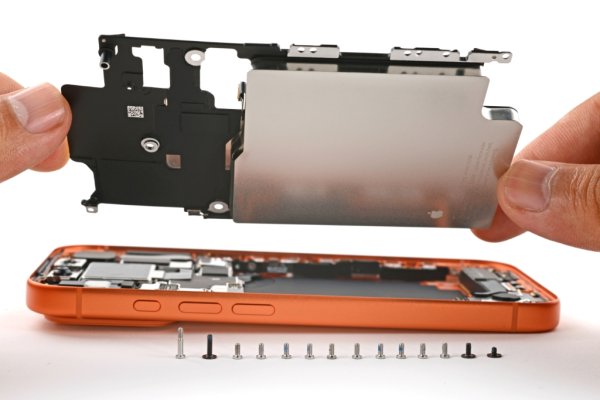


crwdns2944067:00crwdne2944067:0